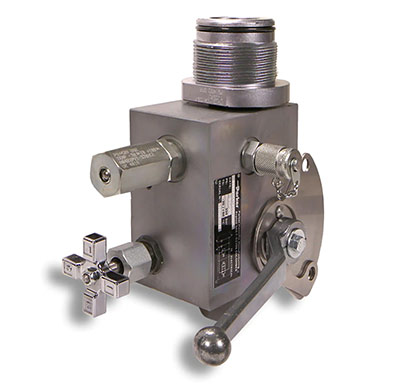Parker Hannifin has introduced a new safety block (SB series) for hydraulic accumulators that simplifies the selection, installation and maintenance process of these important system components. Due to the broad variety of accumulator types and their applications, the market is proliferated with an equally wide expanse of safety blocks that, until now, has made selection challenging for many customers. Developed by the company’s Cylinder and Accumulator Division Europe (CADE), the new safety block overcomes this time-consuming issue.
 Safety blocks enable hydraulic accumulators to be isolated for maintenance work, repairs or system tests, acting as an emergency shut-off device to protect against system failure. Based on the ethos that simple engineering makes for a safer solution, the versatile SB series offers full functionality in a single product: isolation, drain, peak pressure protection and pressure control. As a result, choosing the right safety block is now far easier — regardless of the application. Typical markets set to benefit from the new concept include industrial, mobile, and oil and gas.
Safety blocks enable hydraulic accumulators to be isolated for maintenance work, repairs or system tests, acting as an emergency shut-off device to protect against system failure. Based on the ethos that simple engineering makes for a safer solution, the versatile SB series offers full functionality in a single product: isolation, drain, peak pressure protection and pressure control. As a result, choosing the right safety block is now far easier — regardless of the application. Typical markets set to benefit from the new concept include industrial, mobile, and oil and gas.
Offering an improved design that helps to minimize space requirements and to ease installation, the SB series is available in sizes 10, 20 and 32. Users can enjoy advantages such as a standardized temperature range of –20° to 80°C, and high corrosion resistance compliant with ISO 9227. In addition, the SB series is PED-certified and suitable for use in ATEX environments (manual version only).
Ideal for all bladder, diaphragm and piston-type accumulators, customers can select from models with electric or manual relief valves. The SB series features either a BSPP or SAE accumulator connection, with size 32 offering an SAE accumulator connection as standard. Furthermore, size 32 offers the choice of flanged or threaded hydraulic connection. A variety of voltage options (24 Vdc, 110/120 Vac, 230 Vac) ensure the SB range is suitable for all types of industrial applications, with the pressure range corresponding to the accumulator operating pressure (up to 350 bar).
According to Laurent Nauroy, product manager at CADE, “Our customers have repeatedly asked for a simplification of the previous series. The new SB safety block is the result of this feedback. Our SB series allows for simple design, simple engineering and simple selection.”
As standard, Parker Hannifin supplies its SB series safety blocks without an adapter.
“The concept of accumulators without adapters is based on the desire of our customers to complement an accumulator safety block with different adapters to suit the specific application,” said Nauroy. “This creates more flexibility at lower cost.”
Parker Hannifin, Cylinder and Accumulator Division Europe
www.parker.com
Filed Under: Accumulators